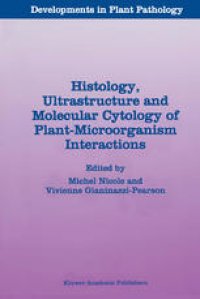
Ebook: Histology, Ultrastructure and Molecular Cytology of Plant-Microorganism Interactions
- Tags: Plant Pathology, Plant Sciences
- Series: Developments in Plant Pathology 7
- Year: 1996
- Publisher: Springer Netherlands
- Edition: 1
- Language: English
- pdf
Plants interact with a large number of microoganisms which have a major impact on their growth either by establishing mutually beneficial symbiotic relationships or by developing as pathogens at the expense of the plant with deleterious effects. These microorganisms differ greatly not only in their nature (viruses, phytoplasmas, bacteria, fungi, nematodes, ... ) but also in the way they contact, penetrate and invade their host. Histology and cytology have brought an essential contribution to our knowledge of these phenomena. They have told us for instance, how specialized structures of the pathogen are often involved in the adhesion and penetration into the plant, how the interface between both organisms is finely arranged at the cellular level, or what structural alterations affect the infected tissues. They have thus set the stage for the investigations of the underlying molecular mechanisms could be undertaken. Such investigations have been remarkably successful in the recent years, expanding considerably our understanding of plant-microorganism interactions in terms of biochemical changes, rapid modifications of enzymatic activities, coordinated gene activation, signal reception and transduction. Biochemistry, molecular biology and cellular physiology have taken precedence in the phytopathologist's set of methods.
This book provides comprehensive, up-to-date descriptions of cellular aspects of interactions between plants and microorganisms, including lichens, and also covers infections by viruses, trypanosomes and nematodes. The detailed reviews are accompanied by nearly 250 appropriate micrographs. Topics covered include:
- techniques that may be of use in studying plant infections such as colloidal gold cytochemistry, in situ hybridization, histochemical detection of polyphenols, cytodetection of pathogens, monoclonal antibodies and image analysis;
- host aggression by bacteria, fungi and nematodes with emphasis on adhesion, penetration and plant cell modifications;
- defense mechanisms of infected plants, including trees, cytolocalization of molecules involved in host resistance, plant responses to parasites or symbiotic microorganisms.
Audience: An invaluable source of information and references for research scientists and students interested not only in plant-microbe interactions but also in cell biology in general.
This book provides comprehensive, up-to-date descriptions of cellular aspects of interactions between plants and microorganisms, including lichens, and also covers infections by viruses, trypanosomes and nematodes. The detailed reviews are accompanied by nearly 250 appropriate micrographs. Topics covered include:
- techniques that may be of use in studying plant infections such as colloidal gold cytochemistry, in situ hybridization, histochemical detection of polyphenols, cytodetection of pathogens, monoclonal antibodies and image analysis;
- host aggression by bacteria, fungi and nematodes with emphasis on adhesion, penetration and plant cell modifications;
- defense mechanisms of infected plants, including trees, cytolocalization of molecules involved in host resistance, plant responses to parasites or symbiotic microorganisms.
Audience: An invaluable source of information and references for research scientists and students interested not only in plant-microbe interactions but also in cell biology in general.
Content:
Front Matter....Pages i-ix
Image Analysis In Biology....Pages 1-20
In situHybridization to RNA in Plant Biology....Pages 21-42
In Situ Detection of Polyphenols in Plant Microorganism Interactions....Pages 43-53
Gold Cytochemistry Applied to the Study of Plant Defense Reactions....Pages 55-77
Use of Monoclonal Antibodies to Study Differentiation of Colletotrichum Infection Structures....Pages 79-97
The Plant Cell Wall, First Barrier or Interface for Microorganisms: In Situ Approaches to Understanding Interactions....Pages 99-115
Adhesion of Fungal Propagules....Pages 117-134
Cellular Aspects of Rust Infection Structure Differentiation....Pages 135-156
Structural and Functional Aspects of Mycobiont - Photobiont Relationships in Lichens Compared with Mycorrhizae and Plant Pathogenic Interactions....Pages 157-176
Root Defence Responses in Relation to Cell and Tissue Invasion by Symbiotic Microorganisms : Cytological Investigations....Pages 177-191
Histology and Cytochemistry of Interactions between Plants and Xanthomonads....Pages 193-210
Compartmentalization in Trees: New Findings During the Study of Dutch Elm Disease....Pages 211-225
Virus of Plant Trypanosomes (Phytomonas Spp.)....Pages 227-236
Plant Cell Modifications by Parasitic Nematodes....Pages 237-244
In Situ Detection of Grapevine Flavescence Doree Phytoplasmas and their Infection Cycle in Experimental and Natural Host Plants....Pages 245-255
Back Matter....Pages 257-262
This book provides comprehensive, up-to-date descriptions of cellular aspects of interactions between plants and microorganisms, including lichens, and also covers infections by viruses, trypanosomes and nematodes. The detailed reviews are accompanied by nearly 250 appropriate micrographs. Topics covered include:
- techniques that may be of use in studying plant infections such as colloidal gold cytochemistry, in situ hybridization, histochemical detection of polyphenols, cytodetection of pathogens, monoclonal antibodies and image analysis;
- host aggression by bacteria, fungi and nematodes with emphasis on adhesion, penetration and plant cell modifications;
- defense mechanisms of infected plants, including trees, cytolocalization of molecules involved in host resistance, plant responses to parasites or symbiotic microorganisms.
Audience: An invaluable source of information and references for research scientists and students interested not only in plant-microbe interactions but also in cell biology in general.
Content:
Front Matter....Pages i-ix
Image Analysis In Biology....Pages 1-20
In situHybridization to RNA in Plant Biology....Pages 21-42
In Situ Detection of Polyphenols in Plant Microorganism Interactions....Pages 43-53
Gold Cytochemistry Applied to the Study of Plant Defense Reactions....Pages 55-77
Use of Monoclonal Antibodies to Study Differentiation of Colletotrichum Infection Structures....Pages 79-97
The Plant Cell Wall, First Barrier or Interface for Microorganisms: In Situ Approaches to Understanding Interactions....Pages 99-115
Adhesion of Fungal Propagules....Pages 117-134
Cellular Aspects of Rust Infection Structure Differentiation....Pages 135-156
Structural and Functional Aspects of Mycobiont - Photobiont Relationships in Lichens Compared with Mycorrhizae and Plant Pathogenic Interactions....Pages 157-176
Root Defence Responses in Relation to Cell and Tissue Invasion by Symbiotic Microorganisms : Cytological Investigations....Pages 177-191
Histology and Cytochemistry of Interactions between Plants and Xanthomonads....Pages 193-210
Compartmentalization in Trees: New Findings During the Study of Dutch Elm Disease....Pages 211-225
Virus of Plant Trypanosomes (Phytomonas Spp.)....Pages 227-236
Plant Cell Modifications by Parasitic Nematodes....Pages 237-244
In Situ Detection of Grapevine Flavescence Doree Phytoplasmas and their Infection Cycle in Experimental and Natural Host Plants....Pages 245-255
Back Matter....Pages 257-262
....